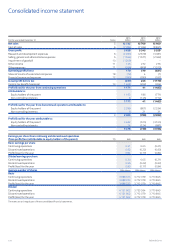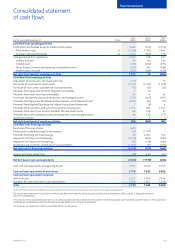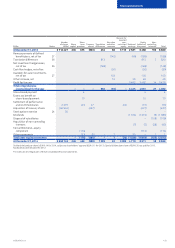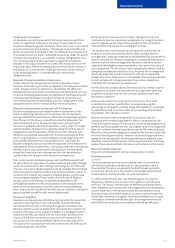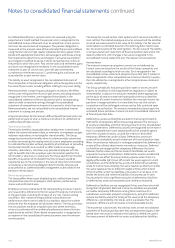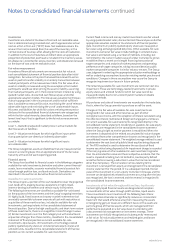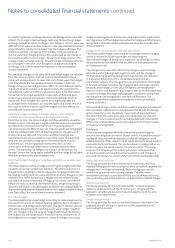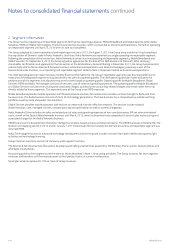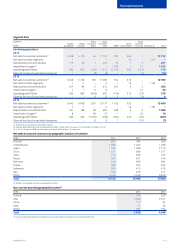Nokia 2014 Annual Report Download - page 134
Download and view the complete annual report
Please find page 134 of the 2014 Nokia annual report below. You can navigate through the pages in the report by either clicking on the pages listed below, or by using the keyword search tool below to find specific information within the annual report.132 NOKIA IN 2014
For dened benet plans, pension costs are assessed using the
projected unit credit method: the pension cost is recognized in the
consolidated income statement so as to spread the current service
cost over the service lives of employees. The pension obligation is
measured as the present value of the estimated future cash outows
using interest rates on high-quality corporate bonds or government
bonds with appropriate maturities. Actuarial gains and losses arising
from experience adjustments and changes in actuarial assumptions
are charged or credited to equity in other comprehensive income in
the period in which they arise. Past service costs and settlement gains
and losses are recognized immediately in the consolidated income
statement as part of service cost, when the plan amendment,
curtailment or settlement occurs. Curtailment gains and losses are
accounted for as past service costs.
The liability or asset recognized in the consolidated statement of
nancial position is the pension obligation at the closing date less the
fair value of plan assets including eects relating to any asset ceiling.
Remeasurements, comprising actuarial gains and losses, the eect
of the asset ceiling and the return on plan assets, excluding amounts
recognized in net interest, are recognized immediately in the
consolidated statement of nancial position with a corresponding
debit or credit to retained earnings through the consolidated
statement of comprehensive income in the period in which they occur.
Remeasurements are not reclassied to the consolidated income
statement in subsequent periods.
Actuarial valuations for the Group’s dened benet pension plans are
performed annually or when a material curtailment or settlement of
adened benet plan occurs.
Termination benets
Termination benets are payable when employment is terminated
before the normal retirement date, or whenever an employee accepts
voluntary redundancy in exchange for these benets. The Group
recognizes termination benets when it is demonstrably committed
to either terminating the employment of current employees according
to a detailed formal plan without possibility of withdrawal, or providing
termination benets as a result of an oer made to encourage
voluntary redundancy. Local laws may provide employees with the
right to benets from the employer upon termination whether the
termination is voluntary or involuntary. For these specic termination
benets, the portion of the benet that the company would be
required to pay to the employee in the case of voluntary termination
is treated as a constructive obligation determined by local law and
accounted for as a dened benet arrangement as described in the
pensions section above.
Share-based payment
The Group oers three types of global equity-settled share-based
compensation plans for employees: stock options, performance
shares and restricted shares.
Employee services received and the corresponding increase in equity
are measured by reference to the fair value of the equity instruments
at the grant date, excluding the impact of any non-market vesting
conditions. Non-market vesting conditions attached to the
performance shares are included in assumptions about the number
of shares that the employee will ultimately receive. The Group reviews
the assumptions made on a regular basis and, where necessary,
revises its estimates of the number of performance shares that are
expected to be settled. Share-based compensation is recognized as
an expense in the consolidated income statement over the relevant
service periods.
The Group has issued certain stock options which are accounted for as
cash-settled. The related employee services received and the liabilities
incurred are measured at the fair value of the liability. The fair value of
stock options is estimated based on the reporting date market value
less the exercise price of the stock options. The fair value of the liability
is remeasured at each statement of nancial position date and at the
date of settlement, with changes in fair value recognized in the
consolidated income statement over the relevant service periods.
Income taxes
The income tax expense comprises current tax and deferred tax.
Current taxes are based on the results of the Group companies and
are calculated according to local tax rules. Tax is recognized in the
consolidated income statement except to the extent that it relates to
items recognized in other comprehensive income or directly in equity,
then the related tax is recognized in other comprehensive income or
equity, respectively.
The Group periodically evaluates positions taken in tax returns with
respect to situations in which applicable tax regulation is subject to
interpretation. It adjusts the amounts recorded, where appropriate,
on the basis of amounts expected to be paid to the tax authorities.
The amount of current income tax liabilities for uncertain income tax
positions is recognized when it is more likely than not that certain
tax positions will be challenged and may not be fully sustained upon
review by tax authorities. The amounts recorded are based upon the
estimated future settlement amount at each consolidated statement
of nancial position date.
Deferred tax assets and liabilities are determined using the liability
method for all temporary dierences arising between the tax bases
of assets and liabilities and their carrying amounts in the consolidated
nancial statements. Deferred tax assets are recognized to the extent
that it is probable that future taxable prot will be available against
which the unused tax losses, unused tax credits or deductible
temporary dierences can be utilized. Deferred tax assets are
assessed for realizability at each statement of nancial position date.
When circumstances indicate it is no longer probable that deferred tax
assets will be utilized, adjustments are made as necessary. Deferred
tax liabilities are recognized for temporary dierences that arise
between the fair value and the tax base of identiable net assets
acquired in business combinations. Deferred tax assets and deferred
tax liabilities are oset for presentation purposes when there is a
legally enforceable right to set o current tax assets against current
tax liabilities, and the deferred tax assets and deferred tax liabilities
relate to income taxes levied by the same taxation authority on either
the same taxable entity or dierent taxable entities which intend
either to settle current tax liabilities and assets on a net basis, or to
realize the assets and settle the liabilities simultaneously in each
future period in which signicant amounts of deferred tax liabilities
or deferred tax assets are expected to be settled or recovered.
Deferred tax liabilities are not recognized if they arise from the initial
recognition of goodwill. Deferred income tax liabilities are provided
on taxable temporary dierences arising from investments in
subsidiaries, associates and joint arrangements, except for deferred
income tax liability where the timing of the reversal of the temporary
dierence is controlled by the Group, and it is probable that the
temporary dierence will not reverse in the foreseeable future.
The enacted or substantively enacted tax rates at each consolidated
statement of nancial position date that are expected to apply in the
period when the asset is realized or the liability is settled are used in
the measurement of deferred tax assets and deferred tax liabilities.
Notes to consolidated nancial statements continued




